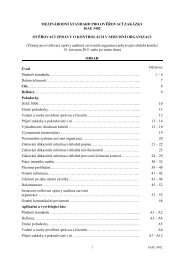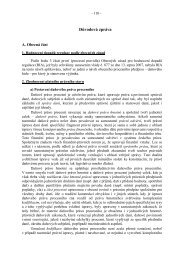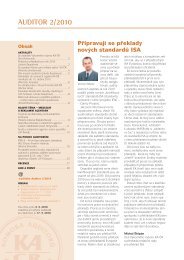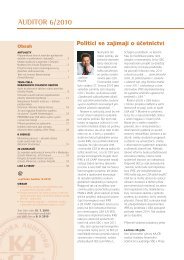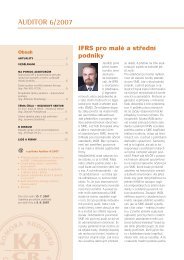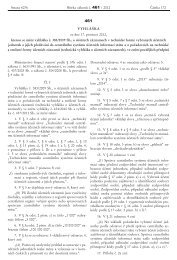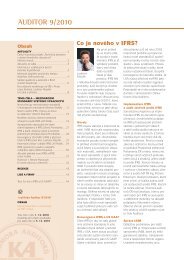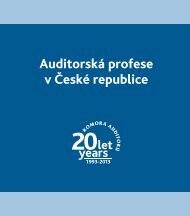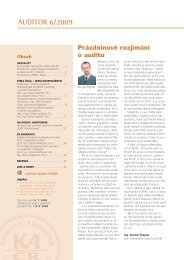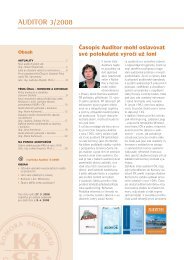Guide to Using International Standards on Auditing in - IFAC
Guide to Using International Standards on Auditing in - IFAC
Guide to Using International Standards on Auditing in - IFAC
Create successful ePaper yourself
Turn your PDF publications into a flip-book with our unique Google optimized e-Paper software.
87<br />
<str<strong>on</strong>g>Guide</str<strong>on</strong>g> <str<strong>on</strong>g>to</str<strong>on</strong>g> <str<strong>on</strong>g>Us<strong>in</strong>g</str<strong>on</strong>g> <str<strong>on</strong>g>Internati<strong>on</strong>al</str<strong>on</strong>g> <str<strong>on</strong>g>Standards</str<strong>on</strong>g> <strong>on</strong> <strong>Audit<strong>in</strong>g</strong> <strong>in</strong> the Audits of Small- and Medium-Sized Entities Volume 1—Core C<strong>on</strong>cepts<br />
7.3 Nature of Misstatements<br />
Misstatements may arise from a number of causes and can be based <strong>on</strong> the follow<strong>in</strong>g:<br />
• Size—the m<strong>on</strong>etary amount <strong>in</strong>volved (quantitative);<br />
• Nature of the item (qualitative); and<br />
• Circumstances surround<strong>in</strong>g the occurrence.<br />
Exhibit 7.3-1<br />
Typical<br />
Misstatements<br />
• Errors and fraud identified <strong>in</strong> the preparati<strong>on</strong> of the f<strong>in</strong>ancial statements;<br />
• Departures from the applicable f<strong>in</strong>ancial report<strong>in</strong>g framework;<br />
• Fraud perpetrated by employees or management;<br />
• Management error;<br />
• Preparati<strong>on</strong> of <strong>in</strong>accurate or <strong>in</strong>appropriate estimates; or<br />
• Inappropriate or <strong>in</strong>complete descripti<strong>on</strong>s of account<strong>in</strong>g policies or note<br />
disclosures.<br />
Materiality is not an absolute number. It represents a grey area between what is very likely not material and<br />
what is very likely material. C<strong>on</strong>sequently, the assessment of what is material is always a matter of professi<strong>on</strong>al<br />
judgment.<br />
In some situati<strong>on</strong>s, a matter well below the quantitative materiality level may be determ<strong>in</strong>ed as material<br />
based <strong>on</strong> the nature of the item or the circumstances related <str<strong>on</strong>g>to</str<strong>on</strong>g> the misstatement. For example, the<br />
<strong>in</strong>formati<strong>on</strong> that there are a number of transacti<strong>on</strong>s with related parties may be very significant <str<strong>on</strong>g>to</str<strong>on</strong>g> a pers<strong>on</strong><br />
mak<strong>in</strong>g a decisi<strong>on</strong> based <strong>on</strong> the f<strong>in</strong>ancial statements. F<strong>in</strong>ally, a series of immaterial items may well become<br />
material when aggregated <str<strong>on</strong>g>to</str<strong>on</strong>g>gether.<br />
Exhibit 7.3-2<br />
Extent of Misstatements<br />
(Quantitative and qualitative)<br />
The Subject<br />
Matter Informati<strong>on</strong><br />
Reas<strong>on</strong>able<br />
User<br />
Misstatements<br />
are<br />
material<br />
Decisi<strong>on</strong> would<br />
be changed<br />
or <strong>in</strong>fluenced<br />
Materiality<br />
threshold<br />
Misstatements<br />
are<br />
immaterial<br />
Decisi<strong>on</strong> would<br />
not be changed<br />
or <strong>in</strong>fluenced




